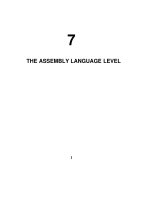Tài liệu THE ASSEMBLY LANGUAGE LEVEL-7 pdf
Bạn đang xem bản rút gọn của tài liệu. Xem và tải ngay bản đầy đủ của tài liệu tại đây (37.93 KB, 20 trang )
7
THE ASSEMBLY LANGUAGE LEVEL
1
Programmer-years to
produce the program
Program execution
time in seconds
Assembly language 50 33
High-level language 10 100
Mixed approach before tuning
Critical 10% 1 90
Other 90% 9 10
Total 10 100
Mixed approach after tuning
Critical 10% 6 30
Other 90% 9 10
Total 15 40
Figure 7-1. Comparison of assembly language and high-level
language programming, with and without tuning.
Label Opcode Operands Comments
FORMULA: MOV EAX,I ; register EAX = I
ADD EAX,J ; register EAX = I + J
MOV N,EAX ; N =I+J
I DW 3 ; reserve 4 bytes initialized to 3
J DW 4 ; reserve 4 bytes initialized to 4
N DW 0 ; reserve 4 bytes initialized to 0
(a)
Label Opcode Operands Comments
FORMULA MOVE.L I, D0 ; register D0 = I
ADD.L J, D0 ; register D0 = I + J
MOVE.L D0, N ; N = I + J
I DC.L 3 ; reserve 4 bytes initialized to 3
J DC.L 4 ; reserve 4 bytes initialized to 4
N DC.L 0 ; reserve 4 bytes initialized to 0
(b)
Label Opcode Operands Comments
FORMULA: SETHI %HI(I),%R1 ! R1 = high-order bits of the address of I
LD [%R1+%LO(I)],%R1 ! R1 = I
SETHI %HI(J),%R2 ! R2 = high-order bits of the address of J
LD [%R2+%LO(J)],%R2 ! R2 = J
NOP ! wait for J to arrive from memory
ADD %R1,%R2,%R2 ! R2 = R1 + R2
SETHI %HI(N),%R1 ! R1 = high-order bits of the address of N
ST %R2,[%R1+%LO(N)]
I: .WORD 3 ! reserve 4 bytes initialized to 3
J: .WORD 4 ! reserve 4 bytes initialized to 4
N: .WORD 0 ! reserve 4 bytes initialized to 0
(c)
Figure 7-2. Computation of N = I + J. (a) Pentium II. (b)
Motorola 680x0. (c) SPARC.
Pseudoinstr Meaning
SEGMENT Start a new segment (text, data, etc.) with certain attributes
ENDS End the current segment
ALIGN Control the alignment of the next instruction or data
EQU Define a new symbol equal to a given expression
DB Allocate storage for one or more (initialized) bytes
DD Allocate storage for one or more (initialized) 16-bit halfwords
DW Allocate storage for one or more (initialized) 32-bit words
DQ Allocate storage for one or more (initialized) 64-bit double words
PROC Start a procedure
ENDP End a procedure
MACRO Start a macro definition
ENDM End a macro definition
PUBLIC Export a name defined in this module
EXTERN Import a name from another module
INCLUDE Fetch and include another file
IF Start conditional assembly based on a given expression
ELSE Start conditional assembly if the IF condition above was false
ENDIF End conditional assembly
COMMENT Define a new start-of-comment character
PAGE Generate a page break in the listing
END Terminate the assembly program
Figure 7-3. Some of the pseudoinstructions available in the
Pentium II assembler (MASM).
MOV EAX,P SWAP MACRO
MOV EBX,Q MOV EAX,P
MOV Q,EAX MOV EBX,Q
MOV P,EBX MOV Q,EAX
MOV P,EBX
MOV EAX,P ENDM
MOV EBX,Q
MOV Q,EAX SWAP
MOV P,EBX
SWAP
(a) (b)
Figure 7-4. Assembly language code for interchanging P and
Q twice. (a) Without a macro. (b) With a macro.
Item Macro call Procedure call
When is the call made? During assembly During execution
Yes NoIs the body inserted into the object
program every place the call is
made?
No YesIs a procedure call instruction
inserted into the object program
and later executed?
No YesMust a return instruction be used
after the call is done?
One per macro call 1How many copies of the body ap-
pear in the object program?
Figure 7-5. Comparison of macro calls with procedure calls.
MOV EAX,P CHANGE MACRO P1, P2
MOV EBX,Q MOV EAX,P1
MOV Q,EAX MOV EBX,P2
MOV P,EBX MOV P2,EAX
MOV P1,EBX
MOV EAX,R ENDM
MOV EBX,S
MOV S,EAX CHANGE P, Q
MOV R,EBX
CHANGE R, S
(a) (b)
Figure 7-6. Nearly identical sequences of statements. (a)
Without a macro. (b) With a macro.
Label Opcode Operands Comments Length ILC
MARIA: MOV EAX,I EAX = I 5 100
MOV EBX, J EBX = J 6 105
ROBERTA: MOV ECX, K ECX = K 6 111
IMUL EAX, EAX EAX = I
*
I 2 117
IMUL EBX, EBX EBX = J
*
J 3 119
IMUL ECX, ECX ECX = K
*
K 3 122
MARILYN: ADD EAX, EBX EAX = I
*
I+J
*
J 2 125
ADD EAX, ECX EAX = I
*
I+J
*
J+K
*
K 2 127
STEPHANY: JMP DONE branch to DONE 5 129
Figure 7-7. The instruction location counter (ILC) keeps track
of the address where the instructions will be loaded in memory.
In this example, the statements prior to MARIA occupy 100
bytes.









